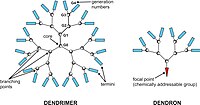
Photo from wikipedia
Abstract Oral administration of drugs is a two-edged sword – on one hand it is a non-invasive and easy-to-handle administration of drugs, on the other hand macromolecular pharmaceutical compounds cannot… Click to show full abstract
Abstract Oral administration of drugs is a two-edged sword – on one hand it is a non-invasive and easy-to-handle administration of drugs, on the other hand macromolecular pharmaceutical compounds cannot easily cross the epithelial barrier to reach systemic circulation or they could be inactivated in the gastrointestinal tract. Due the latter's nature with pH variations and proteolytic enzymes which digest and degrade external compounds, in particular peptides and proteins, oral delivery of macromolecular substances is an ongoing challenge in the field of pharmaceutical research. Several avenues of overcoming these drawbacks have been evaluated in the past, among them the promising approach of conjugation to natural and synthetic polymers. Polymers provide protection under harsh gastrointestinal conditions, may further enhance macromolecular drug absorption and pharmacological activity, and thus augment therapeutic efficiency. This short review highlights state-of-the-art developments in the field of oral macromolecule delivery and the benefit of polymer conjugation. We focus on a main review period from 2012 to 2017, and critically discuss latest developments for macromolecule engineering.
Journal Title: Current Opinion in Colloid and Interface Science
Year Published: 2017
Link to full text (if available)
Share on Social Media: Sign Up to like & get
recommendations!